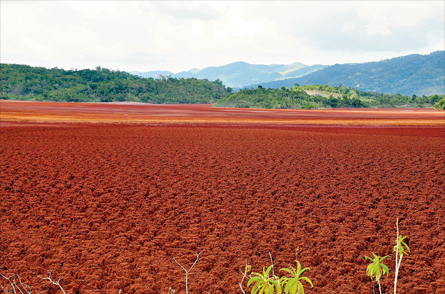(Jamaica Observer) MANDEVILLE, Manchester — A geo-scientist at Northern Caribbean University (NCU) Dr Mark Harris has a tried and proven formula that could transform the island’s potentially harmful bauxite/alumina red mud lakes into lush, tree-growing areas in less than two years.
His formula includes spreading a mixture of gypsum — a soft sulphate mineral quarried in relatively large quantities in the Port Royal Mountains of eastern Jamaica — and decomposable organic matter across red mud lakes.

His method would accelerate the process by which carbon dioxide is absorbed into the earth, thereby preparing the areas for plant life. Nature could do the process itself if the lakes were allowed to remain idle, Harris said, “but the process is a very slow one and could take decades”.
This comes at a time when the public is abuzz with news that waste from Jamaica’s bauxite/alumina processing operations could have high levels of valuable rare earth metals. The Portia Simpson Miller Administration recently announced a $3-million red mud pilot plant project, to be funded by Japanese company Nippon Lights Metals and the Jamaica Bauxite Institute (JBI), to explore the potential.
When contacted last week, head of the JBI Dr Parris Lyew-Ayee said the the institute has been reclaiming inactive red mud lakes “for years” using mainly gypsum. However, he did not say exactly when the process started and was tightlipped about which ponds were currently being treated.
“We did some ponds which are closed… I wouldn’t want to say which ones are being worked on now… We’ve been getting very good results, but the work isn’t complete. There are still experiments to be done,” Lyew-Ayee told the Jamaica Observer Central.
He said a committee was formed five years ago to see to the reclamation of inactive red mud lakes.
The lake at Myersville in South East St Elizabeth, close to the Alpart plant at Nain, and another which serves the Windalco/Kirkvine operation, close to Mandeville have been inactive since 2009 when both plants were closed as a result of high energy costs and the global economic crash.
Such lakes are a constant source of tension between alumina-processing companies and residents of host communities because of the potential for harm to health and the environment caused by the hazardous matter dumped in huge quantities. Trees and grass in the immediate vicinity of such dumps typically die, and in dry, windy weather ,in particular, people in surrounding communities complain of serious health problems caused by dust as well as corrosive damage to their houses, clothing and other property. In the absence of rain, alumina companies are forced to use huge volumes of water to keep the red mud waste wet.
Harris told the Observer Central that his restorative formula was made public in Jamaica in 2004, when he shared it with Ken Evans, an official with RPS International, a global consultancy firm which was in the island courtesy of then bauxite giant Alcan. He said Evans and his team decided to try the formula on a section of the Kirkvine red mud lake.
An Observer news feature published in February 2004 captured Harris’s efforts at the time.
“What we advised RPS to do is to put some readily degradable organic matter in and they dropped some dunder (yeast rich waste from rum production) in…I advised them what quantity of gypsum to put in, it must be done with the dunder, and in a matter of one year, I’m certain it was less than two years, I got a telephone call from Mr Evans. He invited me down there to look at the area … I could not recognise (it) because it was full of large trees. He said he could not believe it, because they didn’t do that much irrigation. But luckily, it was a rainy year,” Harris told the Observer.
Harris said he along with retired NCU scientist Dr Charles Panton worked out a formula for Evans, which advised the consultants on how much gypsum to use with the mixture of dunder.
RPS reportedly contacted the geo-scientist after research Harris did with colleague Dr Pichu Rengasamy, while in Australia, was published in international geoscience journal Environmental Geology.
Reports on the research were also widely covered in the local media at the time.
“We had success in that short time. So there is a formula here. I have not gone back down there to see it, so I don’t know what it’s like now, ” Harris said.
The NCU scientist told the Observer that up to 2004, he had not tried the formula in Jamaica, but encouraged RPS officials to do it, because he had seen the power of degradable organic matter working in these situations. He said both himself and Dr Panton refused to accept payment from RPS, but instead requested a longer-term partnership with the organisation which would benefit the university. The partnership, however, was never realised, as Alcan’s management changed soon after.
Though Harris admits that the gypsum/dunder formula could not be a one-size-fits-all, “as every pond is unique”, he is encouraging the authorities to use the method or a similar composition to replenish greenery in the inactive bauxite mud lakes.
Harris says that, in addition to other dangers, red mud lakes could also disturb ground water if the alkaline content is high and it seeps into the water supply. “Not to mention if someone [falls] in. It is like quicksand, worse than quicksand. It would be very difficult to get out,” he said.








